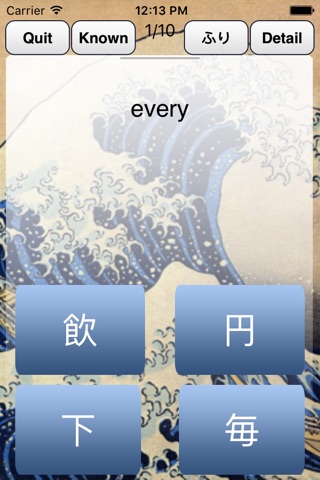
JLPT Study, 1-5 Level Kanji and Vocabulary Japanese Language Proficiency
This application will help you study the vocabulary for the Japanese Language Proficiency Tests (JLPT), level N5, N4, N3, N2 and N1 (N5 being the easiest and N1 the hardest). The split of old N2 into N3 (and new N2 set) is not officially defined and thus up to interpretation.
It also includes the KANJI for level N1 to N5. Note that N3 is subject to interpretation and N3 presented here is an estimation. N2 also contains the N3 subset.
This means that it covers roughly 8 500 words and 2000 kanji. Great care has been taken to reduce the repetition of words in the more advanced levels if they occur in the previous levels.
For each kanij level common kanji compunds are listed to help understand the meaning of the kanij. A kanji is mostly used in combination with other kanjis to make up words. This is something that often is overlooked but is very important to study.
The JLPT (日本語能力試験 nihongo nōryoku shiken) is a standardized test for evaluating the Japanese language proficiency for non-japanese.
The word lists have been screened and corrected by a native Japanese, 作道敦子, with over 2500 corrections and 2000 added level 1 compounds.
The study mode is based on interval as this will effectively reinforce your long term memory of the words.
The interval study will increase the time until next study for a word for each time the word is marked as known. If a word is not known, its score will be reduced and you will have to study it more often until its score has been restored. This makes you focus on words not yet memorized.
As each level contains quite a lot of words, the study set (number of words) can be limited. From the selected set, only the words valid for study (according to the chosen study mode) can be studied. Add more words if the number of due words is zero but you still want to move on.
Each time you start a new study, the selected words will be randomized. After the study session is over, you will see how many words you knew and also where you are in your goal to complete the level.
If you know the word by heart, then mark it as "known" and it will not be tested.
I feel it is very beneficial to see the kanji parts as well as this not only will help you distinguish words with same furigana spelling, but also teach you kanji "for free". It does not hurt to keep it on.
If you do not yet know furigana (hiragana and katakana), make sure to learn it. Very important for studying Japanese. However, until you have mastered furigana there is an option to display romanji spelling.
Remember, even if your goal is not to pass the JLPT, you still can learn tons of new Japanese words to use in your everyday life.
Have fun and keep studying.



